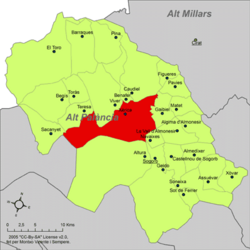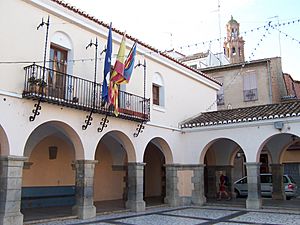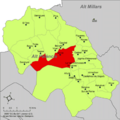Jérica facts for kids
Quick facts for kids
Jérica
|
|||
|---|---|---|---|
|
Town
|
|||
|
|||
 
Location in the Valencian Community, Spain
|
|||

Location in the comarca Alto Palancia
|
|||
| Country | Spain | ||
| Province | Castellón | ||
| Comarca | Alto Palancia | ||
| Area | |||
| • Total | 78.30 km2 (30.23 sq mi) | ||
| Elevation | 523 m (1,716 ft) | ||
| Population
(2018)
|
|||
| • Total | 1,553 | ||
| • Density | 19.834/km2 (51.370/sq mi) | ||
| • Language | Spanish | ||
| Demonym(s) | Jericano/a (Spanish) Xericà/Xericana (Valencian) |
||
| Postcode |
12450
|
||
| Website | Official Website: https://www.jerica.es/ | ||
Jérica (also called Xèrica in Valencian) is a cool town in the Castellón province of Valencian Community, Spain. It's part of the comarca (a type of region) called Alto Palancia. At the end of 2009, about 1,703 people lived there.
The town's name comes from the Arabic word šāriqa, which means "the eastern slope of a mountain." In old Arabian papers, it was also called "Castle of the Sheriffs."
Contents
- Exploring Jérica: Location and Landscape
- Jérica's Past: A Look at History
- Jérica's Important Buildings
- Jérica's Population: Demography
- How Jérica is Run: Administration
- Jérica's Economy: How People Make a Living
- Getting Around Jérica: Transport
- Jérica's Fun Times: Festivals
- Famous People from Jérica
- Images for kids
- See also
Exploring Jérica: Location and Landscape
Jérica is located on a natural path between Aragón and the Valencian Community. This path is in the southern part of the Castellón province.
How Big is Jérica?
The town covers an area of 78.30 square kilometers. The Palancia river flows through it. A part of the Calderona mountain range is in the south of the municipality. However, Jérica is not inside the Sierra Calderona National Park.
Where is the Town Center?
The main part of Jérica is 523 meters high. It sits on a rocky hill next to the Palancia river. This rocky side is hard to reach. So, people built the town on the opposite side of the hill, going up its slope.
Getting to Jérica
You can get to Jérica by car using Highway A-23. Take exit 42 for Jérica-Caudiel. You can also use road N-234. Jérica is about 67 km from Valencia and 74 km from Castellón de la Plana. It's 40 km from Sagunto and 78 km from Teruel.
You can also travel by train. There's a station called Jérica-Viver in the northern part of town. It's on the C-5 Line, which connects to Valencia and Castellón de la Plana.
Jérica's Smaller Areas
The municipality of Jérica has two smaller population centers:
- Los Ángeles
- Novaliches
Neighboring Towns
Jérica shares borders with several towns. These include Altura, Benafer, Caudiel, Gaibiel, Navajas, Sacañet, Segorbe, Teresa, Vall de Almonacid and Viver in the Castellón province. It also borders Alcublas in the Valencia province.
Jérica's Past: A Look at History
The very first signs of people living here are from the Neolithic period (Stone Age). Human remains were found in the Herreros Cave. There are also old settlements from the Iberian period near the castle.
Roman Times
Jérica has more Roman artifacts than any other place in its region. Many Roman gravestones have been found. One special gravestone, from Quintia Prova, even mentions the cost of a Roman arch with two statues!
Muslim and Christian Rule
The first mentions of the town we know today are from when Muslims lived in the area. This was during the time of the Taifa of Valencia. Later, El Cid captured the area in 1098. The oldest parts of the castle and its towers are from this time.
On February 5, 1235, a Christian army took control of the area. But the Muslim people living there were not forced to leave.
In 1249, a special document called the Carta Puebla was issued. This allowed more people to settle in Jérica. In 1255, King James I of Aragon gave control of Jérica to Teresa Gil de Vidaurre and her son, James I, Baron of Jérica. The King also decided that the main road from Aragón to Valencia should go through Jérica, which was a big deal for the town.
Changes in Control
Over the years, Jérica was controlled by different rulers. James I of Jérica, then his son James II, and later James III. James III even got permission to make the town's walls stronger.
Later, Don Pedro of Jérica controlled the town. During this time, there were wars between the kings of Aragón and Castilla. In 1363, the Castilian army entered Jérica and used its castle and church.
After Don Pedro's family line ended, Jérica went back to being controlled by the King of Aragón, Peter IV of Aragon. In 1372, the King gave Jérica to his son, Don Martin, as a special gift.
But Jérica didn't stay under the Crown for long. In 1417, King Alfonso V of Aragon gave control to his brother, Don Juan. Then, in 1431, Don Juan sold it illegally to Francisco Zarzuela. This caused a lot of trouble for the people of Jérica.
Finally, in 1479, the town leaders talked with King Ferdinand. Jérica was then returned to the control of the Crown.
Later History
In 1537, Carlos I of Spain gave Jérica to the Duque de Calabria. After he died, it was given to monks. But the people of Jérica wanted to be under the Crown again. This happened in 1564, during the rule of Felipe I. In 1565, Jérica changed its laws to be like Valencia's laws, instead of Aragón's. Since then, the town has had its own special shield.
In the 1700s, after a big war, King Felipe V created a new title, the Duchy of Liria and Jérica. He gave it to the Duke of Berwick as a reward. This title later passed through the House of Alba.
During the Carlist Wars (1833-1876), soldiers used the Jérica castle and made it very strong. But later, opposing soldiers attacked and destroyed the castle walls.
Jérica was also badly damaged during the Spanish Civil War. The town leaders asked the government for help to rebuild many buildings.
Jérica's Important Buildings
Jérica has been an important place since Roman and Muslim times. It's known for its impressive castle with strong walls and towers.
Tower of the Bells
The Torre de las Campanas (Tower of the Bells) was built in 1634. It has a special Mudéjar style, which is a mix of Christian and Muslim art. It's a unique example of this style in the Valencian Community. Because it's the tallest building, it's the most famous image of Jérica.
The Castle and Watchtowers
Jérica has a castle with Roman foundations. Most of the castle was built during the Muslim period. The best-preserved part is the main tower, called the Torreta. This tower is very strong, with walls over 1.5 meters thick. There are also Muslim watchtowers, Torres de los Ordaces y la Muela, which overlook the castle. They need some repair work now.
Town Plazas
Jérica has two main plazas (town squares). The bigger one is called del Olmo. It's a large, uneven space where the weekly market and yearly fair are held. The smaller plaza is next to a chapel. There are also three smaller plazas named del Loreto, Tiendas (shops), and Carnicerías (meat markets).
Other Buildings
On Arrabal Avenue, near the town center, you'll find the Town Hall. The town's flag flies here. The municipal jail is also in this building. The hospital for people in need is on the same street. There are also several churches, like la Iglesia de Santa Águeda la Nueva in the south, which dates from 1835. A cemetery is located about 150 meters from the town.
Jérica's Population: Demography
In 2005, Jérica had a population of 1,577 people. About 1,482 lived in the main town, and 95 lived in the smaller area of Novaliches.
Population Over the Years
| Year | 1900 | 1910 | 1920 | 1930 | 1940 | 1950 | 1960 | 1970 | 1981 | 1991 | 2000 | 2005 |
|---|---|---|---|---|---|---|---|---|---|---|---|---|
| Population | 3,119 | 3,252 | 2,980 | 2,747 | 2,368 | 2,712 | 2,399 | 2,186 | 1,680 | 1,608 | 1,554 | 1,577 |
How Jérica is Run: Administration
The current mayor of Jérica is Amadeo Edo Salvador. He is from the Socialist Party of Valencia Country.
Jérica's Economy: How People Make a Living
For a long time, farming was very important in Jérica. People grew olive trees, carob trees, and almond trees. Recently, rural tourism has become important. This means visitors come to enjoy the countryside and events like the medieval market.
Getting Around Jérica: Transport
The easiest way to get to Jérica by road is using the A-23 highway from Sagunto to Somport. The town is 67 km from Valencia, 74 km from Castellón de la Plana, 40 km from Sagunto, and 78 km from Teruel.
You can also reach Jérica by train. There's a station called Jérica-Viver near the town. It's on the C-5 line, which connects Valencia and Castellón de la Plana.
Jérica's Fun Times: Festivals
Jérica has many exciting festivals throughout the year!
- January 17 - Fiestas de San Antón: Animals and people are blessed at the church. This is a very old tradition.
- February 5 - Fiesta de Santa Agueda: This is a local celebration for Santa Agueda, Jérica's patron saint. It remembers when the town was taken back by King James I's troops. There's an offering to Santa, a special Mass, and a procession through the streets. Sometimes there are also bullfighting events and other cultural activities.
- Easter Celebrations: The most important events are on Maundy Thursday and Good Friday. There's a night procession for the Blood of Christ, who is also a patron of Jérica. There's also an "Encounter" where statues of Jesus and the Virgin Mary meet after going through different streets.
- Wednesday after Pentecost - The "Joust": This popular event keeps old medieval traditions alive.
- A June Weekend - Sacred Heart of Jesus: This celebration honors the Sacred Heart of Jesus with religious events and a verbena (a lively evening fair).
- Second Wednesday of July - Fiesta del Cristo de la Sangre: This festival started when the Capuchin monks came to the town and brought Christianity.
- Third Sunday of July - Domingo de las Fuentes: On this day, the Municipal Band plays a concert.
- Second Week of August - Virgin of the Abandoned Ones: This celebration is organized by the town's older residents.
- Weekend of August 16 - San Roque: Young people in the town organize celebrations for San Roque. If August 16 isn't a weekend, they use the next weekend.
- First Saturday of September - Romería to the Santa Cave: This is a pilgrimage to the Sanctuary of the Santa Cave.
- Second Weekend of September - Daughters of Maria: This celebration includes religious events and a verbena.
- Third Sunday of September - Fiestas en honor a la Divina Pastora: These are probably Jérica's most popular celebrations! During the first week, there are many events. These include presenting the local fair queens, a Rosary prayer, verbenas, offerings, games, and traditional meals like Bacalá.
Famous People from Jérica
- Baltasar Calvo: A Spanish friar and rebel who died in 1808.
Images for kids
See also
 In Spanish: Jérica para niños
In Spanish: Jérica para niños










